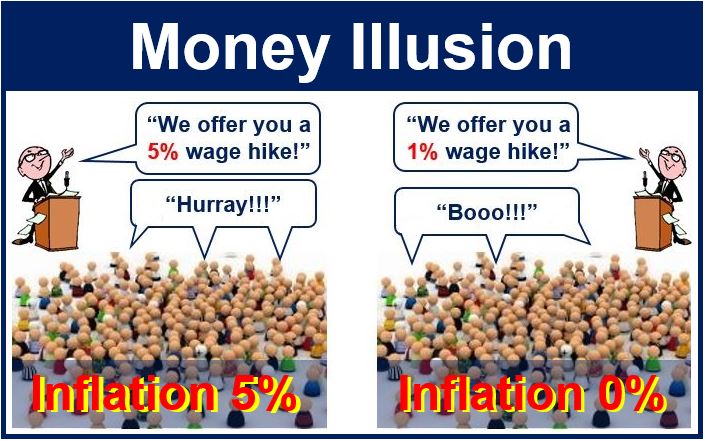Money Illusion refers to a tendency to consider only the *nominal value of money rather that its real value, i.e. to think a dollar is a dollar, today, tomorrow and the day after, instead of realizing that after taking into account inflation, that dollar will buy less in future.
* Nominal value does not take into account the effect of inflation, while ‘real value’ does.
The term ‘money illusion’ was coined by American economist, statistician, inventor, and progressive social campaigner Irving Fisher (1867-1947) in Stabilizing the Dollar. In 1928, Fisher wrote an important book on the subject, The Money Illusion.
According to Fisher, savers and investors are affected by varying degrees of money illusion. British economist John Maynard Keynes (1883-1946) popularized the term.

In 1913, Fisher wrote:
“We have standardized every other unit in commerce except the most important and universal unit of all, the unit of purchasing power. What business man would consent for a moment to make a contract in terms of yards of cloth or tons of cola, and leave the size of the yard or the ton to chance?”
Monetary economists disagree with Fisher and Keynes, insisting that people are aware of the purchasing power of each unit of money and act rationally, i.e. we take into account declining purchasing power.
In times of economic problems, politicians are tempted to use the money illusion approach when trying to calm their citizens.
In 1967, the British Prime Minister Harold Wilson became the butt of cartoonists and comedians after he asserted that the “pound in your pocket will not change value…” He tried to tell the British people that even though the pound had been devalued from $2.80 to $2.40, each person’s pound was still a pound.
Money illusion does influence us
Studies have demonstrated that most people generally perceive a 2% reduction in nominal income with no change in monetary value as ‘unfair’. However, most of us perceive a 2% increase in nominal income when there is 4% inflation as ‘fair’, even though the two are rational equivalents.
In a study published in the Journal of Economic Dynamics & Control, Jianjun Miao and Danyang Xie wrote:
“Empirical and experimental evidence documents that money illusion is persistent and widespread. Money illusion affects an agent’s perception of the growth and riskiness of real wealth and distorts his consumption/savings decisions. It influences long-run growth via this channel.”
Economists say that money illusion means nominal changes in price can affect demand, even if real prices have remained unchanged.
Studies indicate that most people are only free of money illusion in extraordinary situations, such as during periods of hyperinflation, or when focusing on the distant future, such as when discussing a long-term contract.
Interestingly, the money illusion can also impact government policy decisions, as policymakers may prioritize nominal economic indicators over real ones, affecting everything from interest rates to fiscal policies.
Wage negotiations
Economists say employers can keep their wage costs down (as a proportion of earnings) in periods of high inflation, because workers use their nominal pay as a reference point when evaluating wage offers.
This might partly explain why unemployment tends to be lower when inflation is high, compared to periods of very low inflation or deflation (because employers can afford to take on more workers).
Other languages
Money illusion is an economic term that exists in most languages. Here are some translations: Ilusión monetaria (Spanish), Geldillusion (German), Illusion monétaire (French), Illusione monetaria (Italian), Денежная иллюзия (Russian), Iluzja pieniężna (Polish), मुद्रा भ्रम (Hindi), 货币幻觉 (Mandarin Chinese), 貨幣幻覺 (Cantonese Chinese), 金銭の錯覚 (Japanese), Ilusi uang (Indonesian), وهم النقود (Arabic), پیسے کا فریب (Urdu), Ảo tưởng tiền tệ (Vietnamese).
Video – What is Money Illusion?
This educational video, from our sister channel on YouTube – Marketing Business Network, explains what ‘Money Illusion’ is using simple and easy-to-understand language and examples.
